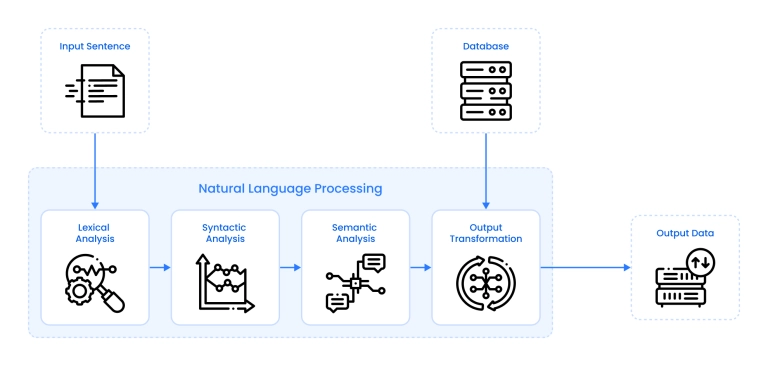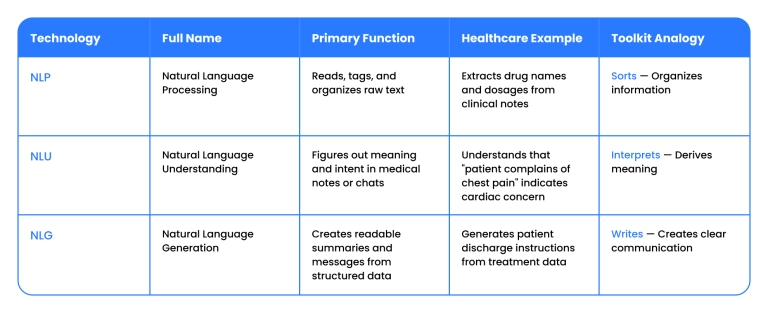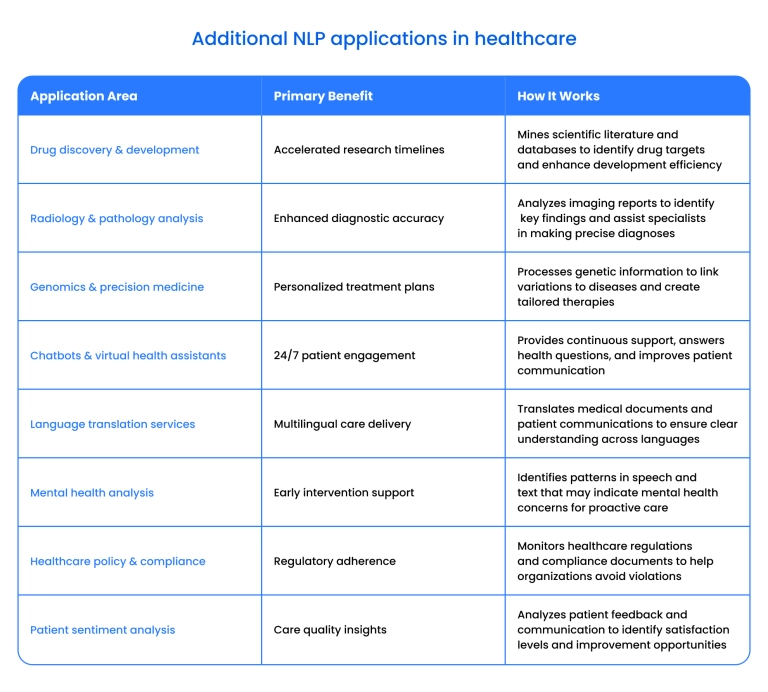Did you know that 80% of clinical data is unstructured, making crucial patient details nearly invisible without the right technology?
From handwritten notes and electronic records to logs from wearable sensors, healthcare organizations deal with a flood of raw information. This constant stream often slows down teams and can cause dangerous delays in care.
However, new advances in natural language processing (NLP) are reducing documentation time by up to 40% and significantly cutting costly errors, helping clinicians turn data headaches into real support.
This article gives you the real story – no hype, just practical advice and solutions.
You'll see how AI-powered speech apps, secure data sharing, and other innovations improve reimbursement, prevent readmissions, and make care more personal. Ready for a faster workflow and long-term value? Let's get started.
What you'll learn:
- How NLP turns messy medical text into clear, actionable intelligence
- Practical applications for coding, compliance, and patient outcomes
- Tips for integrating AI, blockchain, and wearables for privacy and live insights
- Roadblocks including privacy, ethics, bias, and outdated systems – and what to do about them
- Upcoming trends like workforce training and building care that truly fits every patient
NLP in healthcare: The basics
Ever feel buried under endless notes, transcripts, and lab reports? You're not the only one. Healthcare depends on information, but making sense of it isn't easy. NLP in healthcare should be your lifesaver. When you have support from a team that understands the real pain points, you can stop wrestling with clutter and start focusing on what matters.
How NLP makes healthcare work smoother
Natural language processing acts as a sorting machine for all your clinical documentation. When your teams deal with patient histories, discharge summaries, or drug interactions, NLP helps uncover the important details hidden in unstructured text.
Here's what NLP can do for your clinic:
- Data management: Converts messy notes into organized, searchable files fast.
- Clinical decisions: Surfaces critical points and trends so physicians get the full story.
- Patient outreach: Reads free-text feedback, surveys, and messages, letting you understand what patients really want.
That missing piece – the 80% of clinical data that's unstructured – is now within reach for healthcare teams. The right NLP tools bring out information that would otherwise slip through the cracks.
How NLP turns text into intel
NLP isn't magic. It uses a handful of processes to turn words into useful data:
- Data preprocessing: Cleans medical abbreviations, handles formatting inconsistencies, and normalizes terminology before analysis begins
- Tokenization: Breaks medical sentences into meaningful components, accounting for complex medical phrases
- Named Entity Recognition (NER): Identifies and categorizes medical concepts – medications like "Aspirin 81mg," symptoms like "shortness of breath," and diagnoses
- Negation detection: Crucial in healthcare - distinguishes "patient has chest pain" from "patient denies chest pain"
- Temporal extraction: Captures timing information like "symptoms started last Tuesday" or "post-operative day 3"
- Medical concept normalization: Maps terms to standardized medical codes (ICD-10, SNOMED) for consistency
- Machine learning: Identifies patterns, flags at-risk patients, and suggests evidence-based care options

NLP, NLU, and NLG – What's the difference?
All those acronyms can feel overwhelming. Here's a quick breakdown:

Getting medical language right
Healthcare language is full of acronyms, abbreviations, and local slang. It's easy for teams to misread codes or mix up drug names.
NLP tools help by:
- Mapping words and codes to standardized lists (SNOMED, ICD-10, etc.)
- Resolving tricky abbreviations and terms for better accuracy
- Translating doctor-speak to plain wording for patients
Binariks is ready to guide your team through the practical challenges, automate repetitive tasks, and make sure you get value from every data point. Clear language isn't just efficient – it's safer for patients and easier on clinicians. Our support is always there as your team builds knowledge, step by step.
NLP applications: Where healthcare gets smarter
If paperwork and data entry are wearing you out, you're in good company. Healthcare teams everywhere need ways to save time, slash errors, and refocus on care. NLP is changing information handling right now – here's what's possible.
Streamlined charting and coding
Sick of endless charting? Worry that your notes are missing codes? NLP reads through notes, flags gaps, and picks matching codes for billing and diagnoses. With computer-assisted coding, you cut downtime and lower the chance of missing key info.
Example:
NLP scans a doctor's note, grabs mentions of diagnoses or treatments, and maps them right to proper billing codes in seconds. Teams spend less time on paperwork and more on patient care.
EHR data extraction and hands-free charting
Pulling info from electronic health records (EHRs) is often slow and frustrating. NLP reads unstructured notes and summaries, turning them into ready-to-use data. This enables quicker chart reviews and slips trends into view without manual search.
Speech recognition tools take it further: providers can talk into an app during visits, and NLP enters their words straight into the EHR. Errors drop, busywork fades. About 80% of physicians using SR systems saw an improvement in the performance and efficiency of recording their clinical records.
Matching patients to trials, predicting health risks
Connecting patients with clinical trials involves sorting through tons of notes and histories. NLP makes this faster, pulling the medication lists, diagnoses, and lab results that matter.
With predictive analytics, algorithms spot readmission risks or adverse events, letting teams intervene earlier. Hospitals using these tools can save .5 billion annually by preventing avoidable readmissions.
Helping with research and community health
If you work in research or public health, you know the torrent of articles and reports. NLP reads thousands of documents in record time, highlights new drug targets, and traces side effects across entire populations.
For community health teams, NLP checks EHRs and social records to track spreading conditions, spot trends, and cue outreach. Health systems use it to detect outbreaks and tailor care across whole regions.
NLP is a real solution – not just software. With Binariks' NLP expertise, you can cut time on grunt work, build better workflows, and scale up without the stress. Let's talk about how you can work smarter and upskill your staff for the future.
Integrating NLP with new technologies
Wading through overwhelming health data isn't anyone's favorite job. Technologies like AI, blockchain, and connected devices are making it easier to get key insights fast. We support clinics in making sense of the mess and finding answers right when needed.
NLP and AI: Real-time help
You can't wait days for an answer when decisions are urgent. Pairing healthcare-focused NLP with AI means teams get instant insights. Generative AI assistants quickly scan notes and patient records, flagging risks or prepping summaries in seconds.
Picture a nurse who gets notified of allergy risks as soon as they appear in notes. Or a virtual assistant compiling specialist comments before appointments. Your team gets actionable tips instead of endless searching.
LLMs change the patient experience
Tools like ChatGPT power better conversations in healthcare. Patients can speak naturally and get responses they understand. Clinicians get instant summaries that skip jargon and point out errors or gaps.
We've helped networks use LLMs for intake forms, surveys, and early warnings. Fast data isn't the only win – your team gets targeted help when it counts.
Safe, private data with blockchain and IoT
Data security matters. Blockchain and Internet of Things (IoT) devices keep patient details private while sharing only what's needed. Layering NLP on top means data from wearables (watches, sensors) gets sorted and flagged if something's off.
Example:
A patient wears a glucose monitor, feeding info to a secure blockchain. NLP watches for odd patterns in the notes and alerts care teams to risks. Speed and safety work together without risking exposed data.
Remote monitoring and personal alerts
Remote care means more than video visits. Sensors and wearables collect data around the clock, but teams need more than raw numbers. NLP reads sensor logs and patient messages, then sends personalized advice or flags risks.
A smartwatch could read messages about stress or dizziness and shape its daily tips. Clinics get better context and reach patients when it matters most.

NLP benefits, ROI, and platform picks
Managing endless documentation and compliance checks? Mistakes and wasted time can't be part of your plan. Here's how NLP takes that pressure off:
What healthcare teams win from NLP
- Clinicians spend more time with patients and less time searching for data.
- Medication lists and abnormal results are flagged automatically.
- Cut down on manual reviews and overtime, freeing up resources for care.
- Accurate data – NLP processes records endlessly without losing focus.
Staying compliant and getting results
Compliance with HIPAA , GDPR, and local rules is mandatory. NLP flags risky entries, automates audits, and keeps records clean – giving you control over sensitive info.
Compliance and ROI benefits:
- Faster claims and reimbursement
- Lower denial rates
- Less burnout, happier staff
Comparing NLP solutions: What to watch for
You deserve honesty. Some vendors oversell features, others leave big gaps. When choosing a platform, ask:
- Does it fit your EHR and old systems easily?
- Does it know medical language, or just general terms?
- Who supports your system when you run into trouble?
- Can they show results, not just demos?
Proof points: Less burnout, smoother workflow
Healthcare provider burnout affects 25-75% of clinical staff, with documentation burden being a primary driver. AI documentation tools are delivering measurable relief: some clinicians report reducing daily documentation time from 4.7 hours to just 1.2 hours .
Just one example of a real-world validation:
A regional hospital network faced inconsistent documentation leading to medical necessity denials.
After deploying NLP tools to extract relevant data from physician notes and validate medical necessity, they achieved an 18% decrease in documentation-related denials and reduced appeal processing time by 30%.
These results demonstrate that NLP addresses both the human cost of healthcare documentation and the business impact – when clinical staff spend less time on paperwork, the entire organization benefits through improved morale and stronger financial performance.
Facing roadblocks: Ethics, privacy, and getting NLP working
You want better insights, not new security problems. Privacy, quality, and old systems bring real challenges. But you're not alone – we tackle these side by side and stick around for the fix.
Data privacy, security, and cleaning up records
Patient records aren't just numbers – they're personal details. You need strong encryption, tight controls, and transparency at every stage.
Data quality is equally important. Messy, incomplete, or scattered data can throw off patient care. We help you audit and clean up records before rolling out any solution. Your team gets support to keep info accurate and secure, without slowing down daily work.
Getting NLP into old systems and easing annotation
Old hospital software can be a headache to connect to. We focus on compatibility first, map fields, test modules, and prevent breakages.
Annotation – the process of tagging clinical notes – can drag down teams. We build user-friendly annotation systems and automate jobs wherever possible, letting specialists focus on big decisions.
Ambiguity and bias: Tackling tricky problems
Words like "mild" or "negative" mean different things in different notes. If NLP misreads these, care can suffer. We work alongside your clinicians, building custom dictionaries and flagging risky phrases so every decision is trackable.
Bias is another concern. AI models pick up patterns, including those caused by social prejudices. We run bias checks, use broad datasets, and bring your team to review results. Ethics are always built in.
Interoperability and safe sharing
Data flows between systems must follow set standards (HL7 FHIR, secure APIs). We guide your team so that data exchanges are smooth and always encrypted.
Your clinic gets a clear, safe roadmap – and we're there for every update.
Stakeholder buy-in and continuous updates
Bringing NLP to healthcare needs everyone's support – clinicians, IT, managers, and patients. We start with pilot projects and build feedback into every rollout.
Continuous monitoring prevents problems. We set up alerts and dashboards so you spot issues early, and we're always available as clinical rules or tech evolves.
You want a partner, not just a vendor. We're ready to make NLP work for real, together.
Future-proofing your healthcare: NLP trends and training
NLP is moving fast in healthcare. Keeping pace, scaling up, and building a confident team is your next priority. We're here to help you stay out in front.
Staying ready for new technology and rules
Large language models (LLMs) make a difference, helping sift through patient notes, find insights, and support decisions. But compliance rules change just as quickly. HIPAA, GDPR, fresh guidelines: privacy and security need real attention.
Binariks' experts work with you to get it right, setting up processes based on current rules so your NLP application keeps patients safe and audits painless.
Scalable systems that grow with you
Scalability goes beyond adding servers – it means keeping NLP platforms running smoothly, whether you add new patients or launch new features.
We help with:
- Continuous monitoring: Alerts before problems grow.
- Cloud upgrades: Add features without downtime.
- Training and clear documentation: Your staff never feels lost.
Personalized medicine and smart analytics
Real patient histories tie in with research. NLP flags high-risk cases and helps customize therapies, so treatments fit each patient more closely.
Strong data analytics offer dashboards with risk scores, medication lists, and social factors in real time. Care teams miss fewer details and make sharper decisions.
Training your staff for confidence
New tools bring uncertainty for any team. We provide guidance and support to your staff through challenges. You'll see confidence grow alongside knowledge.
Remote monitoring and wearables
Remote care means wearable devices sending streams of health data. NLP checks for warning signs and gives fast alerts if anything trends the wrong way.
For clinics handling chronic conditions or post-surgery monitoring, NLP-powered tools make patients safer and more connected – anywhere.
Binariks is here to support and scale your team, ensuring you deliver patient-focused care. Ready to move healthcare forward together? Let's talk NLP, and make it work for you.
Share

